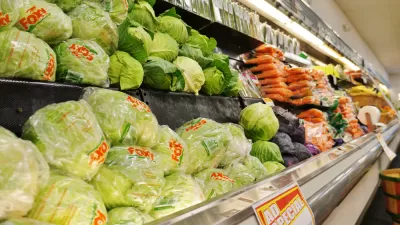Nathanael Johnson reports on what makes healthy grocery stores succeed in food deserts.

While a lot of media attention has been poured over the new Whole Foods store in Midtown district of Detroit, Nathanael Johnson focuses on the success of Metro Foodland, a grocery store that “opened in the midst of Detroit’s depopulation and found a way to thrive while offering healthy foods” for the past 30 years. Contrary to popular notions, “It’s not that grocery executives turn up their noses at poorer neighborhoods; they just couldn’t figure out how to make money there.”
Referring to the success of Metro Foodland, Johnson notes that the key to succeeding as a grocery store in food desert areas is to provide what the customers are used to buying instead of “assuming that people will change their food habits as soon as they have access to brown rice...Even Whole Foods altered its product mix in Detroit, offering fewer organic items and instead emphasizing local foods.”
Success also requires incentivizing health: “Metro Foodland, for example, offers a lot of information about health. It has partnered with a chef to provide classes and healthy shopping lists. It has a small community room full of events. And the store has a rewards card that gives members money back on healthy foods, creating a subtle push toward those items.”
Traditional grocery stores depend on customers who buy weeks' worth of groceries and hauling them home in their cars. “In cities, especially in lower-income neighborhoods, however, people don’t buy as much per trip...But here’s the thing: Those people are going to the store much more frequently and spending almost as much as their more affluent neighbors.”
You also need to think small, but sell a lot: “...fewer items in a smaller space, and an intense engagement with customers to make sure those are the products that will sell.”
FULL STORY: Making food deserts bloom takes more than just a baptism of kale

Planetizen Federal Action Tracker
A weekly monitor of how Trump’s orders and actions are impacting planners and planning in America.

Maui's Vacation Rental Debate Turns Ugly
Verbal attacks, misinformation campaigns and fistfights plague a high-stakes debate to convert thousands of vacation rentals into long-term housing.

San Francisco Suspends Traffic Calming Amidst Record Deaths
Citing “a challenging fiscal landscape,” the city will cease the program on the heels of 42 traffic deaths, including 24 pedestrians.

Amtrak Rolls Out New Orleans to Alabama “Mardi Gras” Train
The new service will operate morning and evening departures between Mobile and New Orleans.

The Subversive Car-Free Guide to Trump's Great American Road Trip
Car-free ways to access Chicagoland’s best tourist attractions.

San Antonio and Austin are Fusing Into one Massive Megaregion
The region spanning the two central Texas cities is growing fast, posing challenges for local infrastructure and water supplies.
Urban Design for Planners 1: Software Tools
This six-course series explores essential urban design concepts using open source software and equips planners with the tools they need to participate fully in the urban design process.
Planning for Universal Design
Learn the tools for implementing Universal Design in planning regulations.
Heyer Gruel & Associates PA
JM Goldson LLC
Custer County Colorado
City of Camden Redevelopment Agency
City of Astoria
Transportation Research & Education Center (TREC) at Portland State University
Jefferson Parish Government
Camden Redevelopment Agency
City of Claremont




























